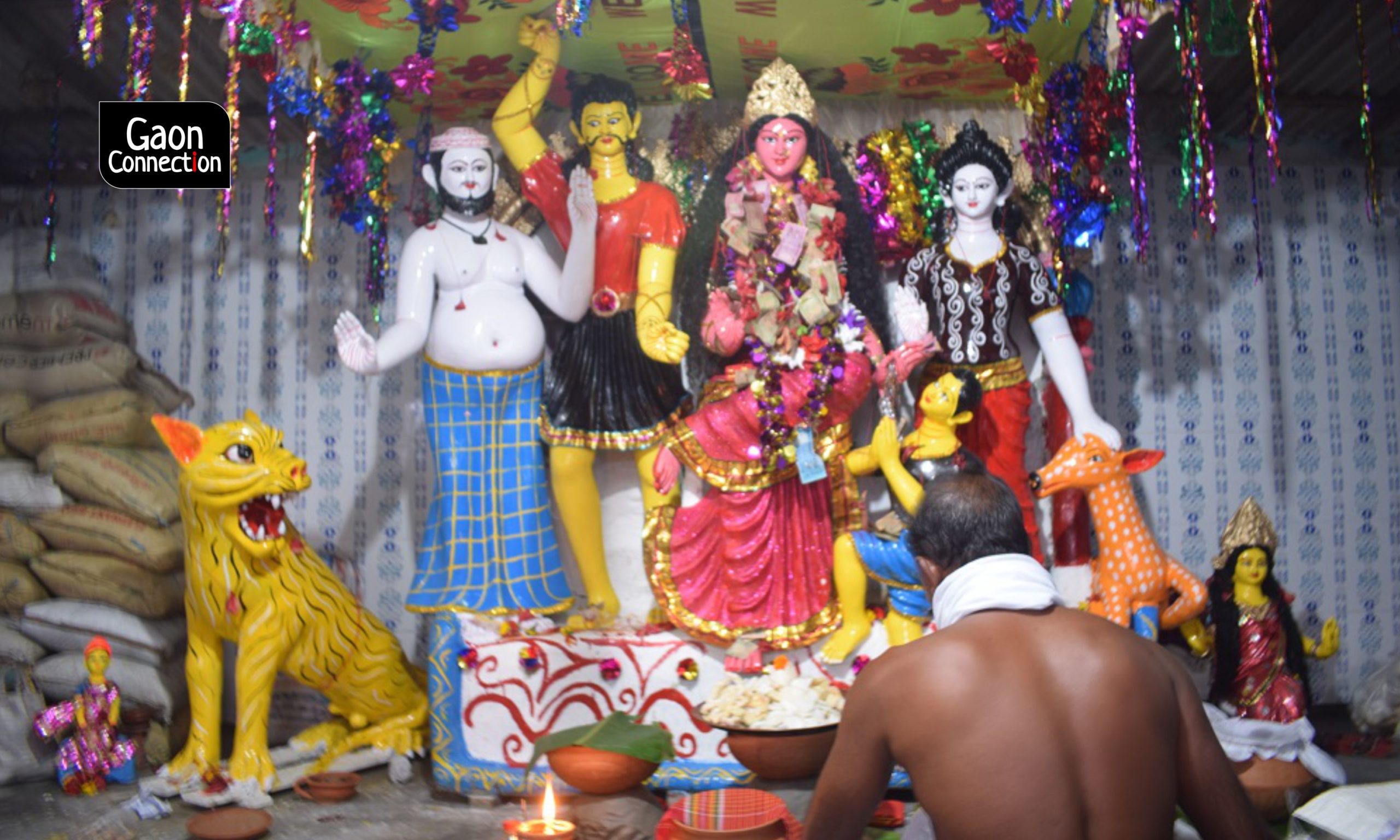Bonbibi to the rescue: On January 15, villagers in the Bangladesh Sundarbans celebrate the forest goddess who protects them
The Bonbibi Puja and Bonbibi Mela in villages adjoining the Sundarbans in Bangladesh cut across religious divides and unite those who depend on the forest, where tiger and crocodile attacks are common. It is believed that Bonbibi protects them in the forest.


Priests at the Bonbibi temple in Charamukha village in Khulna district. Photo: Rafiqul Islam Montu
Koyra, Khulna, Bangladesh
The air is cool, and smoke rises from the stove in Krishna Rani Mandal’s well-stocked, crowded tea shop in Charamukha village, on the banks of the Kopotaksh river. The shop is decorated with shiny orange-print fabric. The mood is festive as this village is the venue for the biggest and most popular Bonbibi Mela in Dakshin Bedkashi Union of Koyra Upazila in Bangladesh.
Bonbibi literally means lady of the forest, but in the Sundarbans delta, divided between India and Bangladesh, Bonbibi is the Goddess of the Sundarbans, the world’s largest mangrove forest. Every year, on January 15, Bonbibi puja and a series of melas are held in coastal parts of Bangladesh. The villagers pray to her so that they can return safely from the forest, and earn a good income.
While Krishna pours out hot tea from the kettle, Satish Chandra Moira is busy in a sweet shop a short distance away. The toy shops are crowded too. There’s food, toys, pottery and more. Among the specialities of the fair are the sports contests and cultural events.

It is the mela, after all, which draws thousands of people and is held around the Bonbibi Puja, which includes reading religious texts, distribution of prasad and remembering Bonbibi’s grace.
“Bonbibi is worshiped in these parts by everyone, irrespective of religion and caste,” 50-year-old Shasodhar Chandra Sana, priest of the Bonbibi temple at Charamukha village, told Gaon Connection. The priest narrates the story of Bonbibi and this is received with great concentration.
Twentyfive kilometres from Koyra Upazila, 45-year-old Karuna Rani Sana pays obeisance to the deity at the Bonbibi temple in Matiabhanga, a remote village near the Sundarbans in Khulna district of Bangladesh, about 220 kilometres from national capital Dhaka.
“There is no one to protect the Sundarbans. Who will save us when we are attacked by tigers and crocodiles? Bonbibi is our hope,” Karuna told Gaon Connection. “She is the one who can save the Sundarbans from danger. So, I pray to her. The first Magh of Bangabda [January 15 as per the English calendar] is very important for us,” she adds.

Karuna lives in Matiabhanga in Dakshin Bedkashi union of Koyra Upazila, where the river Shakbaria flows past the village. The Sundarbans is just across the river and most of the people in this area depend on it for their livelihood.
Some catch crab, some fish, some go to the forest to collect honey. And, through the year, they go about their work with the fear of being caught by surprise by tigers and crocodiles. They believe Bonbibi protects them from such attacks.

How did Bonbibi worship come about?
According to the Bonbibi Panchali (loosely translated as narrative or story) as narrated by the priests, the Bonbibi temple has the idols of Bonbibi’s brother Shah Jangli, Gazi Aulia, son Dukhi, his two uncles Dhan and Mann and Dakshin Roy or the tiger.
There are many origin stories, but here’s one for you. According to the Bonbibi Panchali, many years ago, an underprivileged mother from a village near the Sundarbans took her baby son Dukhi to the forest to collect honey from two businessmen Dhan and Mann.
The mother told the child that he had “another mother like me in the Sundarbans. If you are in any danger, you will call that mother”. There was an auliya (a religious person) named Ghazi in the Sundarbans. Dakshin Roy was an evil force in the form of a tiger, who was friends with Ghazi.
One night, Roy appeared in a dream to Dhan and Mann and told them to sacrifice Dukhi in lieu of wealth. When Dukhi realised he was in danger, he remembered his “other mother”, who rescued him — he floated on the back of a crocodile and reached his mother. Bonbibi later received the status of a goddess.

Bonbibi mela
Bonbibi mela is held at various locations. In Charamukha village, the fair is organised in the open field on the banks of the river Kopotaksh. A loudspeaker system is ready to play music from the venue. Next to it is the Bonbibi temple.
Thousands of people gather at the fair ground adjacent to the Sundarbans in South Bedkashi Union. The road is eroded, some repair work is on, but nothing dampens people’s enthusiasm. For, once the front gate is crossed, everyone has eyes only for the divine Madhumajhi Bonbibi Mandir, which has been seeing people turn up for about 140 years now.
Rafiqul Islam Khokon, director of Rupantar, a not-profit working in the Sundarbans, said history and faith are intertwined in the Bonbibi Puja. Poet Shamsur Rahman, chairperson of Dakshin Bedkashi Union, said many people take vows at the Bonbibi temple, and fulfil them when their wishes are granted.
In many cases, the wishes are very simple — survival when they head to the only place they know for their livelihood, the Sundarbans, a place giving as it can be dangerous.

